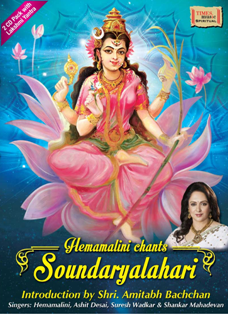 02nd November, 2013
02nd November, 2013
Veteran Bollywood actress Hema Malini launched her debut devotional album “Soundaryalahari”, based on the sacred Hindu Vedic verses, in showbiz Mumbai early this week.
Hema Malini has chanted the sacred verses along with eminent Indian singers like Shankar Mahadevan, Suresh Wadkar and Ashit Desai in the album.
Malini, a trained classical dancer, said her dancing helped her with the album as she is familiar with the Sanskrit text and the basics of music.
“People ask me since when have you been interested in Sanskrit language? But it’s very funny because it is such a beautiful ancient language, which is just deteriorating and that is very sad. I have told you that I have learnt Sanskrit verses and made a TV show called “Noopur” in which I had danced on a particular verse of “Soundaryalahari”. The television show was very popular and it was mostly about dance and that is from there I started learning the verses,” she said.
Renowned Indian classical vocalist Pandit Jasraj, who was also present at the event, praised the actress for her initiative.
“I really enjoyed the music played today. It has been composed beautifully. This music is very much similar to what was going in my mind and I would like to congratulate Ashit Desai for composing such beautiful music,” he said.
Further adding on to the appeal of “Soundaryalahari” is its introduction, which has been narrated by none other than Bollywood megastar Amitabh Bachchan. The prelude explains the relevance and importance of the rich text.
About Soundaryalahari:
For the first time ever, with Hemamalini’s beautiful voice and perfect pronunciation in Sanskrit, Hemamalini chants the complete “Soundaryalahari” along with renowned singers Suresh Wadkar, Shankar Mahadevan & Ashit Desai. The introduction of Soundaryalahari is narrated by Shri Amitabh Bachchan explaining the relevance and importance of this rich text on Tripurasundari.
A mystical poem of Adi Shankaracharya describing the beauty and effulgence of the Divine Mother, Tripurasundari has attracted the attention of commentators and laymen alike for centuries.
At one level it is in fact a poem of rare beauty; at another level it is a Stotra or a hymn in praise of Goddess Tripurasundari. It also encompasses a series of Mantras to be used by the Upasaka along with Yantras - the diagrams, wherein the Devi is conceived to be abiding. It also includes an exposition of Agamas and Tantras bearing on the worship of the Supreme Being in its aspect of Shakti, or the creative energy.
The first 41 stanzas known as Ananda Lahari indicate the way of approaching the Paramatman through true spiritual devotion. Thus this was not meant for the less evolved individual. As a consequence over the ages, certain unwholesome practices crept in the understanding of these hymns deviating from the known vedic injunctions. It fell to the lot of Sri Shankaracharya to reclaim the beauty of this work by removing certain misconceptions and emphasising the importance of Sri Vidya. This he did by incorporating “Soundaryalahari” into the existing text with such conviction that the entire work is now called Soundaryalahari.
The origin of Shakti worship can be traced to such Vedic texts as Sri Suktam, Durga Suktam, Bhu Suktam and Devi Upansihads. In Mahabharata, there is a reference to Shakti worship - Before entering the Matsya Kingdom for spending the last year of his exile, Dharmaputtra prays to Durga. At the commencement of Kurukshetra war, Lord Krishna asks Arjun to get down from the chariot and pray to Durga.
In the Ramayan too, Lord Ram invokes the blessings of the Divine Mother before his battle with Ravan. Rukmini worships at the shrine of Ambika before her marriage.
Shakti is adored as Uma in the Himalayas, Amba in Kashmir, Visalakshi in Varanasi, Bhavani in Maharashtra and Kali in Bengal and by various other names in different parts of the country.
The potency of Soundaryalahari as opposed to other religious texts glorifying the Devi is summed up by Adi Shankaracharya himself; “O! Parabrahmamahisi! The knower of the Vedas call you Vak-devata, the consort of Brahma, Lakshmi, the consort of Vishnu and Parvati, the consort of Shiva. But thou art the Fourth (Turiya) of inconceivable and limitless majesties-the indeterminable Mahamaya who revolves the wheel of this world.”
Soundaryalahari contains the Keshaadipada (head to toe) description of the Mother and offers invaluable benefits to the devotee enjoying the pleasures of the samsara.
“In the path of liberation there is no possibility of material pleasures but those who are engaged in the worship of Tripurasundari, enjoyment and liberation both are at hand.”
